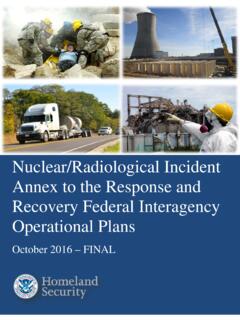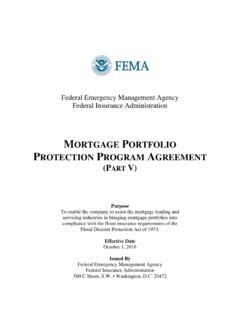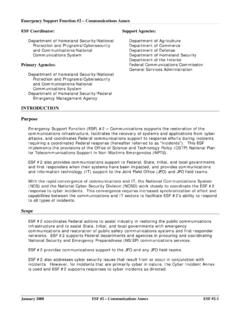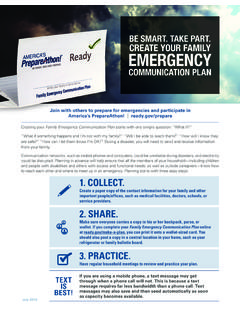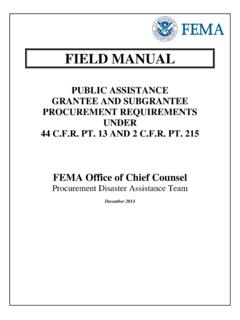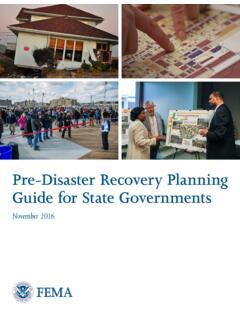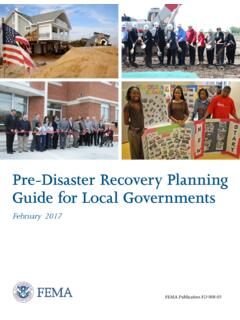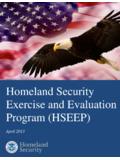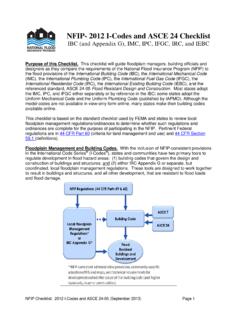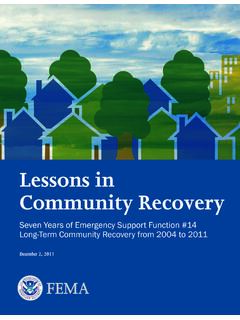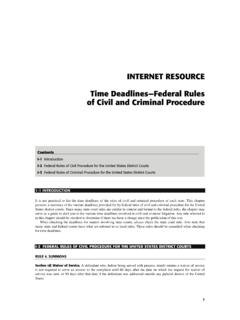Transcription of FY 2010 NIMS Implementation Objectives and Metrics for ...
1 FY 2010 nims Implementation Objectives and Metrics for federal Departments and Agencies Page 1 of 41 May 2010 FY 2010 nims Implementation Objectives and Metrics for federal Departments and Agencies Introduction Homeland Security Presidential Directive 5 (HSPD-5) Management of Domestic Incidents called for the establishment of a single, comprehensive national incident management system. As a result, the Department of Homeland Security released the National Incident Management System ( nims ) in March 2004. nims provides a systematic, proactive approach guiding departments and agencies at all levels of government, the private sector, and nongovernmental organizations to work seamlessly to prepare for, prevent, respond to, recover from, and mitigate the effects of incidents, regardless of cause, size, location, or complexity, in order to reduce the loss of life, property, and harm to the environment.
2 This consistency provides the foundation for Implementation of the nims for all incidents, ranging from daily occurrences to incidents requiring a coordinated federal response. The nims document, as revised in 2008, reflects contributions from stakeholders and lessons learned during recent incidents. federal departments and agencies play an important role in ensuring effective nims Implementation ; not only must they implement nims within their departments and agencies, they must also ensure that the systems and processes are in place to communicate and support nims compliance at all jurisdictional levels. The long-term goal of nims is to provide a consistent template for all aspects of emergency management and incident response.
3 This template should be sustainable, flexible, and scalable to meet changing incident needs and allow for integration of other resources from various partners through mutual aid agreements and/or assistance agreements. federal nims Implementation In 2004, a memorandum to the departments and agencies from the Secretary of Department of Homeland Security recommended departments and agencies to adopt the nims and use it in their individual domestic incident management and emergency prevention, preparedness, response, recovery, and mitigation activities. Since that time, the FEMA National Integration Center (NIC) has engaged its federal stakeholders to expand on this foundation and add additional activities each developed to enhance the way that incidents are managed at all levels of government.
4 Specifically, this memorandum outlined the following important first-steps for the successful Implementation of the nims : FY 2010 nims Implementation Objectives and Metrics for federal Departments and Agencies Page 2 of 41 May 2010 1. Identify existing or anticipated FY 2005 federal preparedness assistance programs HSPD-5 established ambitious deadlines for nims adoption and Implementation , including the requirement that, beginning in Fiscal Year 2005, federal departments and agencies make adoption of the nims a requirement, to the extent permitted by law, for providing federal preparedness assistance through grants, contracts, or other activities. FY 2005 was a start up year for nims Implementation and full compliance with the nims was not required for grantees to receive FY 2005 grant funds.
5 Grantees were encouraged to direct preparedness assistance (beginning in FY 2005) to implementing the nims (in accordance with the eligibility and allowable uses of the grants). Also, federal departments and agencies were asked to identify any existing or anticipated programs that provide preparedness assistance (grants or contracts that contribute to building preparedness and response capabilities) to States and local entities along with a point of contact and contact information for each program. 2. Submit a plan for adopting and implementing the nims By December 31, 2004, the head of each federal department and agency was required to submit a plan to adopt and implement the nims . The Assistant to the President for Homeland Security reviewed plans and advised the President on whether such plans effectively implement the nims .
6 federal department and agency plans must reflect full adoption and Implementation of the nims by September 30, 2005. 3. Incorporate the nims into Emergency Operations Plans All department and agencies were immediately to incorporate nims concepts, principles, and terminology into existing Emergency Operations Plan (EOP), Comprehensive Emergency Management Plan (CEMP), or other similar plans. federal nims Implementation in FY 2010 In FY 2010 , there are 22 Implementation Objectives for federal Departments and Agencies (reference Attachment 1). Beginning in FY 2010 , federal departments and agencies can measure progress of nims Implementation through responses to performance-based Metrics . The NIC coordinated a federal work group in 2006-2007, which crafted the nims Implementation Metrics .
7 (reference Attachment 2). Additionally, NIC will expand its nims Compliance Assistance Support Tool (NIMSCAST) to incorporate both federal department users and accounts. As with State, territory, tribe, and local governments, the NIMSCAST provide federal departments and agencies with a way to collect and report data relating to nims Implementation . NIC will analyze this data to help shape the future of its nims Implementation at the federal level. FY 2010 nims Implementation Objectives and Metrics for federal Departments and Agencies Page 3 of 41 May 2010 The breakdown of nims Implementation Objectives and Metrics , by nims component, is as follows: Summary nims Component Ob jectives Metrics Adoption and Infrastructure 1-6 1-15 Preparedness [Planning, Training, Exercises] 7-12 16-25 Communication and Information Management 13-14 26-28 Resource Management 15-17 29-31 Command and Management [ICS/MACS/Public Information] 18-22 32-40 FY 2010 nims Implementation Objectives and Metrics for federal Departments and Agencies Page 4 of 41 May 2010 Attachment 1.
8 nims Implementation Objectives The 22 Implementation Objectives for federal Departments and Agencies are below: NNIIMMSS IImmpplleemmeennttaattiioonn OObbjjeeccttiivvee Adoption 1. Formally adopt nims within federal department/agency and encourage formal nims adoption as appropriate by external partners (trade associations, private sector partners, contractors, grantees, and vendors) with incident management responsibilities. 2. Designate a single point of contact within the department/agency to serve as the principal coordinator for nims Implementation . 3. Promote or encourage other external partners and stakeholders without formal or legal agreements to adopt nims formally.
9 4. Develop a phased nims Implementation Plan for each specific department/agency. 5. Annually verify department/agency progress on nims Implementation . 6. To the extent permissible by federal laws and regulations, incorporate measurement of nims Implementation into existing department/agency audits and reviews of incident management preparedness funding ( , grants, future year contracts). Preparedness 7. Revise and update department/agency incident management plans and standard operating procedures/standard operating guidelines to incorporate nims components, terminology, principles, and policies. 8. Promote the department/agency, non-governmental and private sector use of cooperative agreements ( Mutual Aid Agreements, Memorandums of Understanding/Agreement, Letters of Agreement, and Interagency Agreements).
10 9. Implement nims training to include appropriate personnel (as identified in the Five-Year nims Training Plan, released February 2008) and in accordance with their incident management responsibilities. 10. Incorporate nims into all applicable department/agency incident management exercises and evaluation programs ( , the Homeland Security Exercise and Evaluation Program (HSEEP). 11. Evaluate the Implementation of nims in all department/agency incident management exercises to identify gaps in Implementation . 12. Incorporate nims corrective actions into department/agency preparedness/response plans and procedures. Communication and Information Management 13.)
